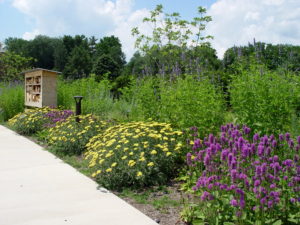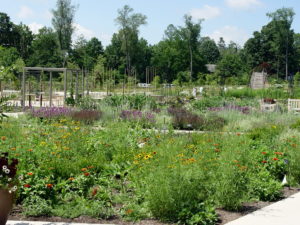How Native Do You Have to Go to Make the Birds and Bees Happy?
July 27th, 2021
The designers of Penn State Arboretum’s new Pollinator and Bird Garden leaned heavily on research to determine the features, layout, and plant selection of this three-acre garden, which opened last month just down Park Avenue from Beaver Stadium.

That’s non-native yarrow and betony growing in Penn State’s new Pollinator and Bird Garden.
Spots of it are very colorful already.
But what struck me during my opening-day visit was that almost all of the showiest plants were non-native perennials – yarrow, Russian sage, catmint, salvia, and one of my favorite summer perennials, betony ‘Hummelo’ with its long-lasting flower spikes of pinkish-purple.
What gives? Aren’t we supposed to be planting native plants if we want to attract pollinators?
Well, yes and no.
Just about everybody agrees that on the whole, native plants are the best bet for attracting the most bees, pollinating insects, birds, and hummingbirds.
It’s hard to go wrong pollinator-wise if you load up the yard on nothing but natives.
But the message that not everybody is getting is that many non-native plants – especially perennials – are also useful to pollinators.
Dr. Douglas Tallamy, author of the ground-breaking “Bringing Nature Home” book (Timber Press, $19.95, 2009) says that of the top 50 pollinator-attracting perennials, 34 of them are U.S. natives… which means that 16 are not.
That’s important because of the not-always-mentioned fact that a lot of native perennials just aren’t that great-looking to people.
Some have unimpressive blooms, some have floppy, “messy” growth habits, many look “beat-up” at times (usually from the feeding activities of the desired pollinators), and some seed around to the point of weediness.
When people aren’t expecting that and/or aren’t OK with that, the result can be a bad experience and a return to the traditional lawn.
“The truth is a lot of pollinator plants are not that exciting to people,” said Dr. Harland Patch, a Penn State entomologist who’s director of pollinator programming at Penn State Arboretum. “So what we’ve done is interplant good pollinator plants with the best of the non-natives… Purism is not the point of this.”
Patch says that for pollinator-friendly gardening to catch on with the masses, people have to be happy with the look.
The British reached a similar conclusion in a 2015 study that found that 1.) native plants aren’t always the No. 1 choice of pollinators, 2.) many non-native plants provide value to beneficial wildlife, and 3.) a mix of natives and non-natives is a sound way to go if you’re trying to accomplish the important goal of having something in bloom continuously throughout the season.
“These findings will help gardeners confidently pack their borders, window boxes and (yards) with flowers without getting hung up on the idea that they are somehow doing the ‘wrong thing’ if the plants are not all U.K. natives,” a report from Britain’s Royal Horticultural Society said.

This section of Penn State’s new Pollinator and Bird Garden is a home-demonstration area that includes fruits, vegetables, and annual flowers.
Patch says a big part of Penn State’s Pollinator and Bird Garden is encouraging gardeners to make their home gardens more pollinator-friendly.
While some people are OK with the tradeoff of a somewhat wild-looking and not-so-colorful landscape if it maximizes pollinator aid, Patch says most people like color and at least a touch of organization and neatness in their gardens.
“Gardens are supposed to be enjoyable to us, too,” he says.
By mixing “people-friendly” plants with “pollinator-friendly” ones, Patch says it’s possible to make everyone happy.
In other words, it’s not an either-or proposition.
For one thing, not all pollinators are U.S. natives either.
Shari Edelson, the Arboretum’s operations director, says the best-known example is the honeybee, an important fruit and nut pollinator that originally hails from Europe.
As a result, she says, “a lot of European plants are preferred by honeybees and highly attractive to them.”
Rather than hyper-focus on each plant’s native heritage, Patch says a more common-sense approach is to encourage home gardeners to do two things: 1.) plant more native plants, and 2.) plant more flowers of many kinds.
“Diversity is the key,” he says. “If you want a diversity of insects, you need a diversity of plants that bloom throughout the year.”

This is one of two large ponds at Penn State’s Pollinator and Bird Garden.
Also helpful is to do what Penn State’s Pollinator and Bird Garden does – provide as many different habitats as possible.
This garden has two ponds, wooded areas, flat open space, hills and mounds, boulders, seven different soil types, four different kinds of drainage, a variety of bee “hotels,” fruits and vegetables among the 350 different kinds of plants, and even two dead “snag” to serve as perch points for hawks.
Few home gardeners can provide all of that, but the more diversity in habitat and plants you can offer, the more different kinds of pollinators you can expect.
Every little bit helps, says Edelson.
“You don’t need a prairie up to your front door to make a difference,” she says.
Some of the best native pollinator-attracting perennials are: aster, baptisia, black-eyed susan, boneset, coreopsis, Culver’s root, liatris, gaillardia, golden alexander, golden ragwort, goldenrod, Joe Pye weed, milkweed, monarda, mountain mint, penstemon, perennial sunflower, purple coneflower, tall garden phlox, and rattlesnake master.
Some of the best non-native, pollinator-attracting annual and perennial flowers are: agastache, ageratum, allium, betony, catmint, cornflowers, cosmos, lavender, Mexican sunflowers, pentas, Russian sage, salvia, sedum, verbena, veronica, yarrow, and zinnia.
Read more on natives vs. non-natives when it comes to pollinator-attracting
Read George’s PennLive column on the opening of Penn State’s Pollinator and Bird Garden







